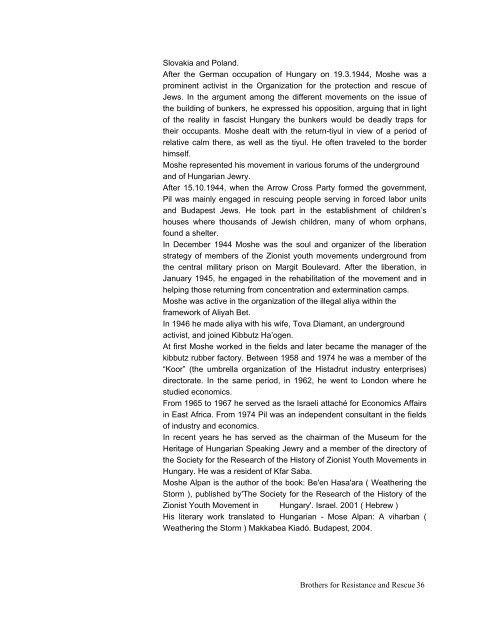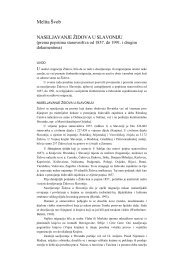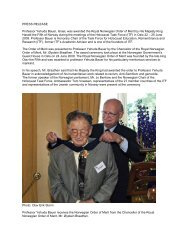Brothers for Resistance and Rescue 1 - CENDO
Brothers for Resistance and Rescue 1 - CENDO
Brothers for Resistance and Rescue 1 - CENDO
You also want an ePaper? Increase the reach of your titles
YUMPU automatically turns print PDFs into web optimized ePapers that Google loves.
Slovakia <strong>and</strong> Pol<strong>and</strong>.<br />
After the German occupation of Hungary on 19.3.1944, Moshe was a<br />
prominent activist in the Organization <strong>for</strong> the protection <strong>and</strong> rescue of<br />
Jews. In the argument among the different movements on the issue of<br />
the building of bunkers, he expressed his opposition, arguing that in light<br />
of the reality in fascist Hungary the bunkers would be deadly traps <strong>for</strong><br />
their occupants. Moshe dealt with the return-tiyul in view of a period of<br />
relative calm there, as well as the tiyul. He often traveled to the border<br />
himself.<br />
Moshe represented his movement in various <strong>for</strong>ums of the underground<br />
<strong>and</strong> of Hungarian Jewry.<br />
After 15.10.1944, when the Arrow Cross Party <strong>for</strong>med the government,<br />
Pil was mainly engaged in rescuing people serving in <strong>for</strong>ced labor units<br />
<strong>and</strong> Budapest Jews. He took part in the establishment of children’s<br />
houses where thous<strong>and</strong>s of Jewish children, many of whom orphans,<br />
found a shelter.<br />
In December 1944 Moshe was the soul <strong>and</strong> organizer of the liberation<br />
strategy of members of the Zionist youth movements underground from<br />
the central military prison on Margit Boulevard. After the liberation, in<br />
January 1945, he engaged in the rehabilitation of the movement <strong>and</strong> in<br />
helping those returning from concentration <strong>and</strong> extermination camps.<br />
Moshe was active in the organization of the illegal aliya within the<br />
framework of Aliyah Bet.<br />
In 1946 he made aliya with his wife, Tova Diamant, an underground<br />
activist, <strong>and</strong> joined Kibbutz Ha’ogen.<br />
At first Moshe worked in the fields <strong>and</strong> later became the manager of the<br />
kibbutz rubber factory. Between 1958 <strong>and</strong> 1974 he was a member of the<br />
“Koor” (the umbrella organization of the Histadrut industry enterprises)<br />
directorate. In the same period, in 1962, he went to London where he<br />
studied economics.<br />
From 1965 to 1967 he served as the Israeli attaché <strong>for</strong> Economics Affairs<br />
in East Africa. From 1974 Pil was an independent consultant in the fields<br />
of industry <strong>and</strong> economics.<br />
In recent years he has served as the chairman of the Museum <strong>for</strong> the<br />
Heritage of Hungarian Speaking Jewry <strong>and</strong> a member of the directory of<br />
the Society <strong>for</strong> the Research of the History of Zionist Youth Movements in<br />
Hungary. He was a resident of Kfar Saba.<br />
Moshe Alpan is the author of the book: Be'en Hasa'ara ( Weathering the<br />
Storm ), published by'The Society <strong>for</strong> the Research of the History of the<br />
Zionist Youth Movement in Hungary'. Israel. 2001 ( Hebrew )<br />
His literary work translated to Hungarian - Mose Alpan: A viharban (<br />
Weathering the Storm ) Makkabea Kiadó. Budapest, 2004.<br />
<strong>Brothers</strong> <strong>for</strong> <strong>Resistance</strong> <strong>and</strong> <strong>Rescue</strong> 36




